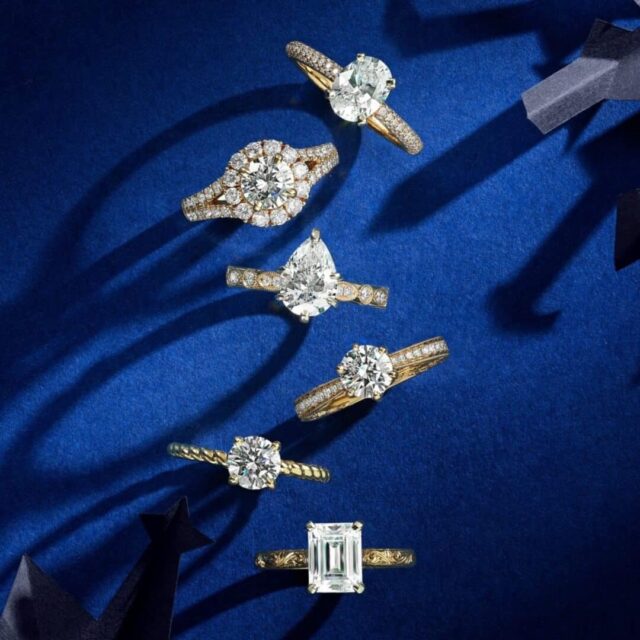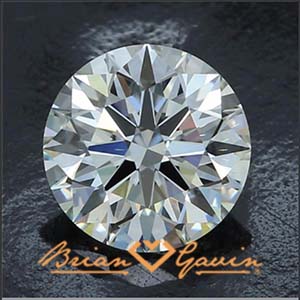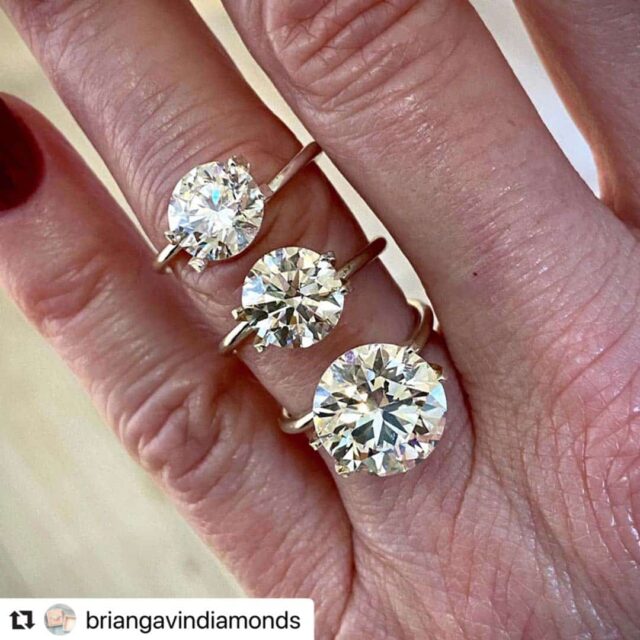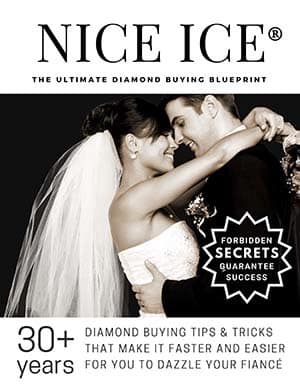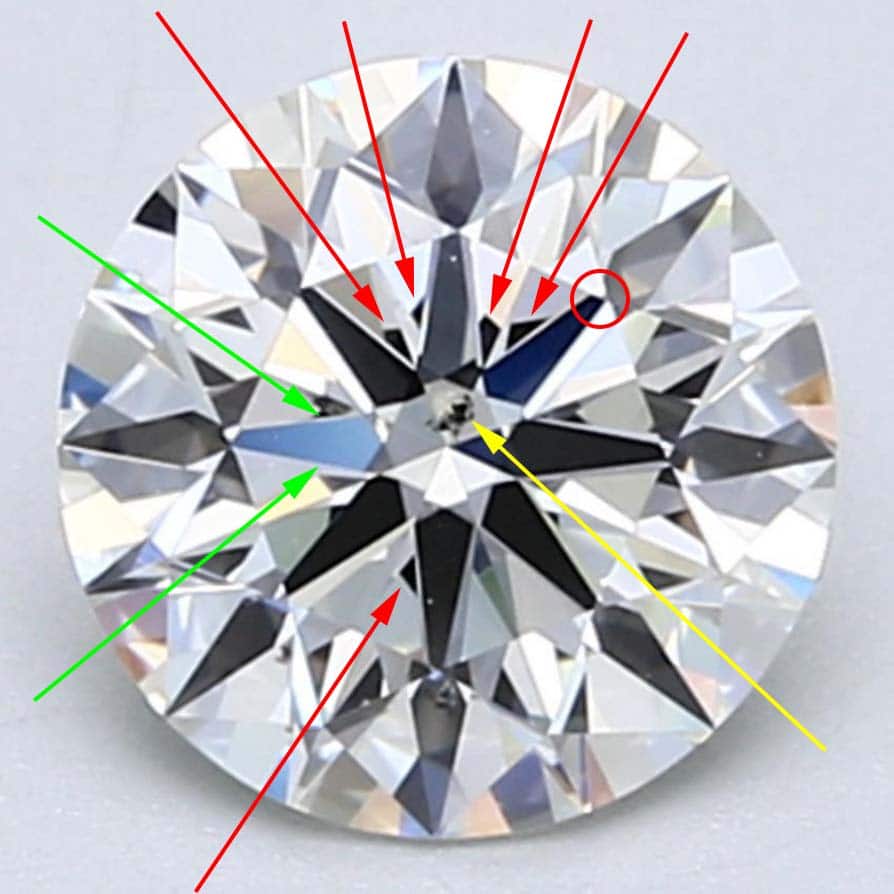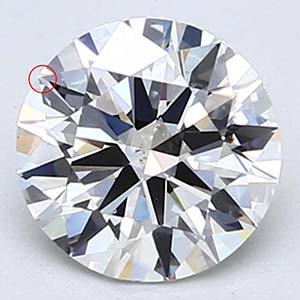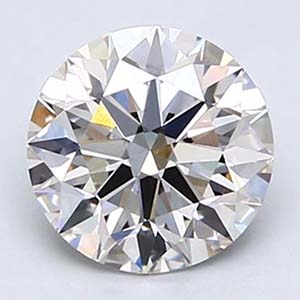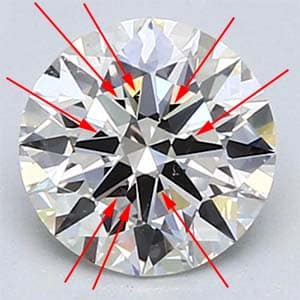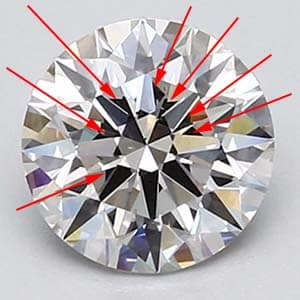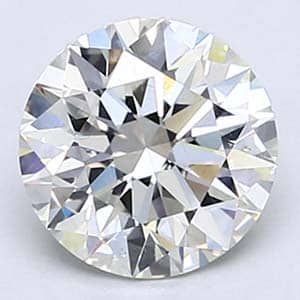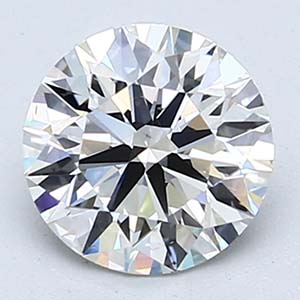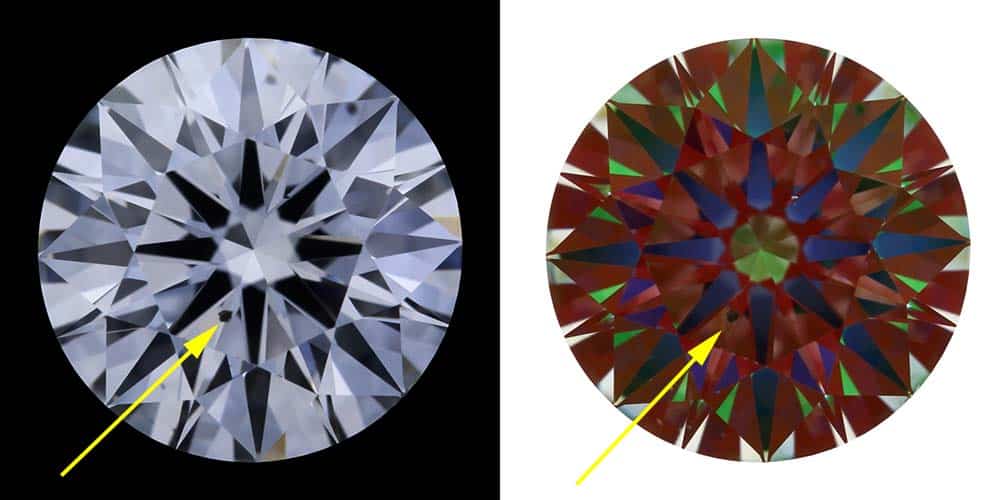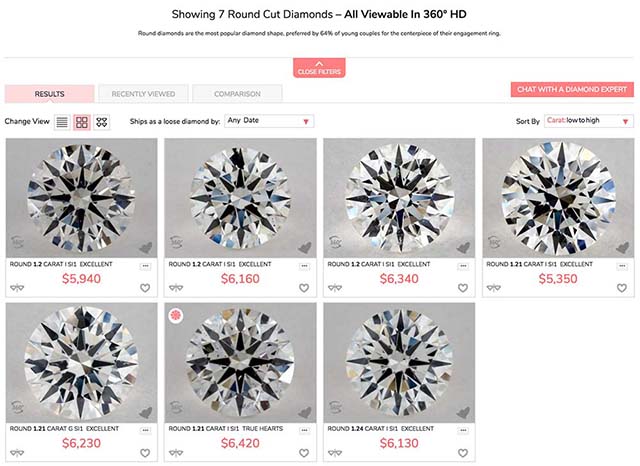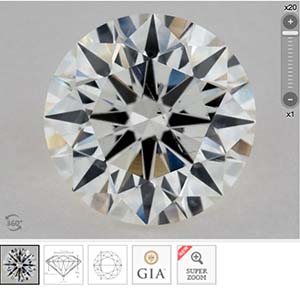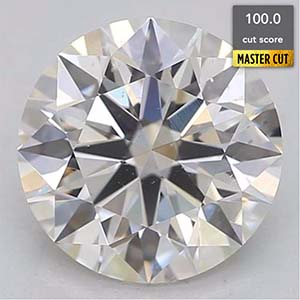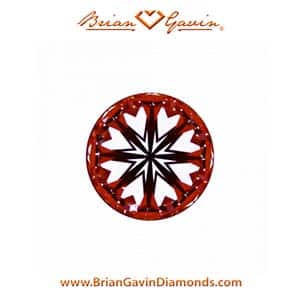People often wonder about GIA Excellent vs. Very Good cut diamonds. Will the difference in light performance be something you can see? The short answer is yes.
You will likely see a performance difference between very good and excellent cut diamonds. The lack of consistency and precision increases the occurrence of light leakage.
In other words, the differences between overall cut ratings aren't something that only occurs on paper. For that reason, it is worth paying slightly more for AGS Ideal or GIA Excellent.
Consequently, this post began simply enough and stemmed from the inquiry below. Throughout time it's grown into an extensive tutorial on diamonds' physical properties and different cut grades.
GIA Excellent vs Very Good Cut Inquiry:
It’s straightforward and to the point.
"Can you provide me with some feedback on this specific stone please?" Referring to this 1.325 carat, K-color, VS-2 clarity, Brian Gavin Signature hearts and arrows round diamond.
You’ll see from my initial response below, that I give this diamond a glowing review. However, the client has some concerns about the K-color looking warm.
What’s cool about this inquiry from my perspective, is that this client asked me to search diamonds with very good cut.
Which opens the door to write a great tutorial about the difference between GIA Excellent vs Very Good cut diamonds. As a diamond buyer with 30+ years experience, I don't waste much time thinking about the difference between GIA Excellent and very good cut diamonds.
However, it makes sense that you might be wondering about the difference in sparkle factor between diamonds of different cut grades. So, I’m super excited to have the opportunity to address this concept for you.
My Initial Response:
The 1.325 carat, K-color, VS-2 clarity, Brian Gavin Signature round diamond will be stunning! The 40.9 degree pavilion angle should produce a high volume of light return.
While the 34.7 degree crown angle produces a virtual balance of brilliance (white sparkle) and dispersion (colored sparkle/fire).
The higher degree of optical precision which creates the hearts pattern pictured to the left and the 78% lower girdle facet length will produce broad-spectrum sparkle.
That means that the sparkle will be larger in size, and be bolder, brighter, and more vivid than what standard ideal cut diamonds exhibit.
I wrote a blog post awhile back on K-color diamond engagement rings, which might answer any additional questions you might have. Our free Diamond Concierge Service can help you find the best looking options.
Naturally, the Client Had More Questions:
"The K-color scares me – should it? I was ALWAYS told to go with at least an I-color, and the K and I-colors differ drastically. If I sent you over some parameters would you help point me in the right direction of where to look?
I’ll use your links obviously when we find the right stone to make sure you get compensated."
Of Course. Of Course. Of Course. Fire Away!
The thing with a K-color diamond is that it’s going to face-up a little warmer than an H-I color diamond. However the sparkle factor and light performance will be the same Brian’s Signature production.
It’s really all a matter of personal preference and what your expectations are. Have you read my article on the perception of diamond color? It’s kind of long, but many people find it helpful.
And of course, I’m more than happy to help you look around and figure out what the best options are. Just send me your preferred parameters. Do you have a setting in mind? If so, please send me a link to that as well.
By the way, the diamond that I selected for my own wedding ring was an I-color diamond with distinct blue fluorescence. That’s a bit strong on the fluorescence front for most people, but it also made a great teaching stone. Nobody ever seemed to notice the body color of the diamond, because most people find that I-color faces-up white.
The diamond that I helped my mom pick out was M-color, because she prefers the warmer tones. The sparkle factor was the same, because I always focus on the ideal and super ideal classification. So, as you can see, it really is just a matter of personal preference.
The Client’s Diamond Selection Criteria:
Thanks for the insight. I think I’m going to steer clear from the K-color diamond from Brian Gavin.
Here are some of the minimum characteristics I’m looking for:
If you could give me your non-biased opinion as to which stone in my parameters would be best, I’d greatly appreciate it.
GIA Excellent vs Very Good Cut Diamonds:
Here is my response to the client. It’s a bit long, but I think you’ll find it super informative:
Thank you for providing me with your range of preferences. The only thing that concerns me is the minimum cut grade of Very Good. Because that means a significant decrease in the volume of light return and sparkle factor.
I’m really hoping that I can convince you to raise the bar and adhere to my preferred range of selection criteria. Because that will produce spectacular visual performance!
Our Blueprint for Diamond Buying Success:
If you haven’t already done so, download the Nice Ice Diamond Buying Blueprint™. Then you can print out and keep beside you while you’re looking!
Brian Gavin doesn’t have anything within this new range of price and characteristics. This is truly a shame because he produces some of the finest diamonds I’ve ever seen.
With exception of one other diamond cutter, who produces diamonds of comparable quality. Unfortunately, they don’t have anything either.
The two of them used to produce the super ideal cut diamonds that we sold under our private label. They are truly outstanding.
However, their diamonds do cost more than standard ideal cut diamonds because it takes about 4X longer to produce the higher degree of optical precision.
Super Ideal Performance vs GIA Excellent vs Very Good Cut:
If we were talking sports cars, I’d say that a Brian Gavin Signature diamond performs like a Porsche 911 GT3.
While a Black by Brian Gavin collection series is up there with the GT2. These diamonds represent the Top 0.001% of the annual production of round brilliant cut diamonds.
When we step down into the realm of the standard ideal cut diamonds, that’s more like a standard Porsche 911. The performance is going to be better than average, but it’s not turbo-charged.
The vast majority of those diamonds don’t exhibit higher degrees of optical precision. They are not fine tuned to deliver the light performance and sparkle factor of hearts and arrows.
The majority of GIA Excellent and AGS Ideal cut diamonds fall into the Top 1-2% of the annual production for rounds. Keep in mind that each cut grade represents a range or spectrum of proportions.
Thus, there is a high end, a low end, and somewhere in between. That means a lower volume of light return, more light leakage, and less intense sparkle. In short, it means a lower level of performance.
There is a substantial difference in the sparkle factor of Super Ideal vs GIA Excellent vs Very Good cut diamonds. If we drop down into the realm of very good, you’re definitely going to see a big difference in light return.
Very good cut diamonds tend to leak a substantial amount of light. In fact, the light performance can drop by as much as 25% and it’s a real crap shoot.
Just the same, let’s see what I can find by running a couple of searches. At the very least this might make an interesting blog post.
GIA Excellent vs Very Good Cut Diamonds from Blue Nile:
The two primary factors that dictate light performance and proportions and light return. Thus, I’m going to try and find options that are as close to my preferred range of proportions as possible.
I set the total depth between 59 – 61.8% because this will provide good spread in terms of outside diameter. If we set the total depth deeper than that, you’ll just end up paying a premium for diamond carat weight which is buried in total depth.
Then I set the table diameter between 53 – 58% because I find this creates a really nice balance in terms of the overall look of the stone. I dropped the cut grade down to very good, instead of the Ideal to Astor Ideal range that I usually use.
Interestingly enough, this only increased the available options to 9 from the 7 diamonds that were available when I had it set to very good.
Be sure to look at the full size images of the diamonds on the diamond details pages.
Don’t simply rely upon the smaller images that I am using as reference points. Click on the links and see what the full size images of the diamonds look like. Because that is the perspective you’re going to be using while shopping for diamonds online.
Here are the options available from Blue Nile within the range you specified. We’ll run through each one just for educational purposes. Click on the links to open each diamond details page in a separate tab in your browser.
Blue Nile GIA Excellent cut diamond reviews, GIA 2238474684:
This 1.20 carat, H-color, SI-1 clarity, GIA Excellent cut round diamond from Blue Nile has a pavilion angle of 40.6 degrees, which should produce a high volume of light return.
The crown angle of 35.5 degrees is a little steep, and this is likely to create a hint more dispersion (colored sparkle). Whereas a crown angle between 34.3 – 35.0 degrees should produce a virtual balance of brilliance (white sparkle) and dispersion.
The red arrows point to areas that I refer to as obstruction. In this case, these are probably due to the steeper crown angle and a lesser degree of optical precision. This phenomena occurs then the star facets begin to reflect up under the table facet.
Consequently, the effect is different than the normal clustering that occurs at the base of the arrows in hearts and arrows diamonds. This type of obstruction frequently shows up as light leakage in ASET and Ideal Scope images. The red circle in the relative one o’clock region highlights the separation between the arrow shaft and the arrowhead.
Notice how far off those two components of the diamond really are. Then look at the junction points for the other arrows and you’ll see that is an anomaly. Last but not least, we’ve got that whopping chunk of black carbon staring at us from smack-dab in the middle of the table facet!
How Lower Girdle Facet Length Affects the Arrows Pattern:
The GIA indicates that the lower girdle facet length is 80% however it looks closer to 78% to me. The reality is that the GIA rounds this measurement off to the nearest 5% and thus 78% would be rounded up to 80%.
Notice how the arrow shaft located in the relative 9 o’clock position and highlighted by the green arrows, appears to be broader than the rest. This is an indication that there might be a difference in the size of the lower girdle facets that border the pavilion mains.
It’s also probably worth noting that this is the only pavilion main facet that is translucent. It’s probably polished slightly off kilter. Thus, it is failing to reflect back the dark color of the camera lens.
Is this SI-1 clarity diamond eye clean?
The supplier indicates that the diamond is "eye clean” within their notes. However, the thing is that the industry standard for determining whether a diamond is eye clean is kind of sketchy. It simply means that a trained grader was unable to "readily and immediately” identify the inclusions from 9 – 12 inches.
Now tell me, are you going to look at your diamond any closer than that? From my perspective, this looks like a "Lucky SI-1 clarity diamond” which is a lot closer to SI-2 and it’s not likely to be eye clean if you really scrutinize it.
GIA Very Good Blue Nile Diamond Review, GIA #2183349938
This 1.20 carat, H-color, SI-1 clarity, round brilliant cut diamond from Blue Nile has Very Good Symmetry. Can you tell by looking at how light is reflecting throughout the diamond in the clarity photograph?
Look at the difference in the arrows pattern, compared to the GIA Excellent cut diamond above.
Here’s a thought. Ignoring the fact that light is reflecting through this diamond as if it were shattered glass, what’s up with the tip of the arrow in the 10 o’clock position?
We’re going to call that pavilion main "stubby” because it’s clearly missing a couple millimeters. Then look at the alignment of the arrowheads and the rest of the arrow shafts. Obviously there is an issue with how the facets are lining up on this diamond, which is why it only got very good for symmetry.
With this in mind, can you imagine what good symmetry must look like?!?! Sadly, I actually know the answer to that question (which is why I focus on super ideal cuts). Interestingly enough, the diamond grading report shows that the cut grade is GIA Excellent. But how can that possibly be right?
If the overall cut grade is based upon the combination of polish, proportions and symmetry. Shouldn’t it default to the lowest graded parameters? That’s how it works at the American Gem Society Laboratory. Clearly the GIA is also confused about the whole GIA Excellent vs Very Good cut thing.
GIA Excellent Blue Nile Diamond Review, GIA #2185513563
This 1.20 carat, I-color, GIA Excellent cut round diamond from Blue Nile has a pavilion angle of 40.8 degrees, which should produce a high volume of light return.
But then why does the diamond appear to be so dark and lifeless under the table facet?
The most probable answer is the 36.5 degree crown angle which is super steep by my standards. Round brilliant cut diamonds rarely perform well under diffused light with a crown angle steeper than 35.5 degrees.
This diamond has lower girdle facets in the range of 75% so the sparkle should be larger in size and bolder in appearance.
However, take a good look at the arrows pattern. Do you see how erratic they are in size and shape? Once again, there is probably a difference in the size of the lower girdle facets. And what about the degree of contrast brilliance that is visible throughout the arrows pattern?
It’s not really up to par, is it? And yet, even with all of these things affecting the light performance of this diamond, it still has an overall cut grade of GIA Excellent.
As you can plainly see, there is a wide range of possibilities to be found within the GIA Excellent cut grade. Imagine the difference in light performance between GIA Excellent vs Very Good cut diamonds if there is this much variance within the spectrum for the GIA Excellent Cut grade.
GIA Excellent #5256985172, Blue Nile diamond review:
This is going to be a fun one! This 1.20 carat, I-color, SI-1 clarity, GIA Excellent cut round diamond from Blue Nile shows what happens when the crown angle is too shallow.
While the pavilion angle of 40.8 degrees should produce a high volume of light return. The shallow crown angle of 33.5 degrees is throwing all of that light away and creating a ton of obstruction.
I also want you to focus in on the table facet of this diamond, and see how the larger table facet and shallow crown angle is creating a kind of sucking-in black hole type of effect.
Here again, the diamond has kind of a splintered, scattered, shattered glass type of reflective property. I’m sure that you’re beginning to see the effect that proportions and optical precision have upon the visual properties of a diamond. Which of course, is the intent of this tutorial.
It’s not exactly the kind of thing that most people in the diamond industry are going to teach you to look for. It’s not that they’re necessarily trying to hide anything from you. It’s more likely that they simply don’t have the same experience evaluating diamonds that I do.
After you’ve evaluated 10’s of thousands of ideal cut diamonds, you start to notice this type of stuff. Suddenly GIA Excellent and AGS Ideal cut become more like the starting line, instead of the end all be all of diamond cut quality. To be perfectly honest, the concept of GIA Excellent vs Very Good cut never even crosses my mind these days.
GIA Excellent #2258977715, Blue Nile diamond review:
This 1.21 carat, I-color, VS-2 clarity, GIA Excellent cut round diamond from Blue Nile has a pavilion angle of 41.2 degrees. It is quite apparent in the clarity photograph, how much this is affecting the light return.
Notice how dark the diamond appears to be under the table facet in terms of hue and saturation.
I also want you to notice, the heavy volume of obstruction under the table facet. And then there’s the low levels of contrast brilliance visible in the arrows.
Would it surprise you to discover that the pavilion depth of 43.5% happens to be "the critical tipping point” where light begins not to fully strike off the pavilion facets?
Probably not, because this diamond doesn’t appear to be reflecting a high volume of light, does it? Do I even have to point out how the tips of the arrows are disjointed and appear to be bending away from the arrow shaft?
And by chance, have you noticed the brownish-yellow undertones visible in these diamonds of lower cut quality? It’s as if the borderline proportions and lesser degree of optical precision makes these diamonds look warmer than I-color diamonds.
Or is it that the higher degree of optical precision improves light return and creates more sparkle, so other I-color diamonds look whiter and brighter? That’s another consideration in the difference between GIA Excellent vs Very Good cut diamonds.
Blue Nile GIA Excellent Cut Diamond Reviews, GIA #1253201955
This 1.23 carat, H-color, SI-1 clarity, GIA Excellent cut round diamond from Blue Nile obviously exhibits better optical precision than the last one. There is less obstruction visible under the table facet.
The arrows pattern is showing up stronger with more consistency. Although as you can see, the arrows in the 3 and 9 o’clock positions are clearly out to lunch.
Unfortunately, the inclusions make it look like buckshot from a shotgun blast are ripping through the stone! But even if that were not the case, I would not recommend this diamond.
The 36 degree crown angle is too steep for my preferences. The steeper crown height tends to make diamonds look amazing under pin-fire type lighting. Such as the filtered halogen lighting used by most jewelry stores to create the Disneyland Diamond Effect.
Unfortunately, the sparkle tends to flatten out and the diamonds go dead when viewed under diffused lighting. And as it just so happens, we spend the majority of our time living and working under diffused lighting in this modern age.
On a positive note, the 40.6 degrees pavilion angle should a high volume of light return. While the 75% lower girdle facet length produces sparkle which is larger in size and bolder in appearance.
This diamond might have been a contender, if the inclusions were better and the crown angle was shallower. Hopefully, looking at all of these diamonds is teaching you what to look for. The difference between Super Ideal vs GIA Excellent vs Very Good cut diamonds is HUGE.
GIA Excellent #7246392313, Blue Nile Diamond Reviews:
Check out the arrows pattern on this 1.23 carat, I-color, SI-1 clarity, GIA Excellent cut round diamond from Blue Nile. What is up with that? The diamond is completely devoid of contrast brilliance!
It’s also exhibiting a really high concentration of obstruction under the table facet. Do you think it might have anything to do with the 44% pavilion depth?
Remember that 43.5% happens to be the critical tipping point where light begins not to strike fully off the pavilion facets! I love being able to share these examples with you, because I know that you’re learning from seeing them.
Obviously the 35.0 degree crown angle is perfectly fine. Under normal circumstances that would produce a virtual balance of brilliance and dispersion. Just as the 75% lower girdle facets should be creating sparkle which is larger in size and bolder in appearance.
The thing is that diamonds are like a 3 dimensional puzzle with moving parts. If any of those parts are out of alignment, or the wrong size and shape, then the diamond just isn’t going to look right. In this particular instance, it seems to me like there are a lot of pieces out of alignment. In the battle of GIA Excellent vs Very Good cut quality, it seems like this one might be sitting on the fence.
Blue Nile GIA Excellent Diamond Reviews, GIA #1182349943
This 1.27 carat, I-color, SI-1 clarity, GIA Excellent cut round diamond from Blue Nile has the right proportions. The 40.6 degree pavilion angle should produce a high volume of light return.
While the 35.0 degree crown angle produces a virtual balance of brilliance and dispersion. The 80% lower girdle facet length should produce pin-fire type sparkle.
So why does the pattern of light return look so choppy in the clarity photograph? If you guessed "optical precision” then you’re probably right.
People tend to confuse the symmetry grade on the lab report with optical precision. The fact is that they are two very different, but somewhat similar concepts. The symmetry grade on the lab report refers to "meet point symmetry” which is how well the junction points of the facet meet-up.
Whereas optical precision is the consistency of facet shape, size, and alignment from the perspective of 360 degrees. The gemological laboratories actually do not take optical precision into account as part of their grading process! The only way to really judge optical precision is using a hearts and arrows scope. However, in this case, it’s pretty apparent to me that this diamond is lacking it.
Blue Nile GIA Excellent Diamond Review, GIA #6262292449
Oh, now this is exciting! This 1.30 carat, H-color, GIA Excellent cut round diamond from Blue Nile has very good polish and symmetry. Pause for effect. Did you catch that? If not, go back and read that last line one or two more times.
How can a diamond have an overall cut grade of GIA Excellent, if the polish and symmetry grades are very good?!?!
Take a good look at the lab report. I couldn’t make this stuff up if I tried. Moving on. By this point, you probably don’t need the diamond grading report to tell you that the symmetry is very good.
You can probably see that for yourself. Just look at how the light is reflecting throughout this diamond. You also know that the 43.5% pavilion depth is the kiss of death. And you can see how the steeper pavilion depth is affecting the tonality of the table facet region.
You’re probably also able to see the sucking-inward, black hole type of effect being created by the super shallow 32.5 degree crown height. You can clearly see how the 80% lower girdle facet length is making the pavilion mains look like pinstripes in this case.
What’s interesting is that the primary inclusion is readily and immediately visible in the clarity and ASET image provided by the cutter. However, it’s hiding rather nicely in the video provided on Blue Nile.
My guess is that it’s being hidden by the obstruction at this particular vantage point. By the way, the black hole effect looks kine of cool in the multi-colored ASET scope image.
Search James Allen for GIA Excellent vs Very Good Cut Diamonds:
I’m wondering whether you can apply what you’ve learned thus far. Which of the following diamonds should you consider based upon the images?
Take a second to relax and really look at these diamonds. Which one appears to offer the most consistent pattern of light return?
You’re on the right track if you think the 1.21 carat, I-color, SI-1 clarity, James Allen True Hearts diamond in the middle of the second row is the best option. Because it’s the only one where the arrows pattern doesn’t look broken and spindle-like, right?
Not surprisingly, it has a 40.8 degree pavilion angle, which should produce a high volume of light return. While the crown angle of 34.5 degrees produces a virtual balance of brilliance and dispersion. The 75% lower girdle facet length should produce sparkle that is larger in size and bolder in appearance.
The hearts pattern is showing some minor variances, but it is certainly better than anything we’ve seen thus far. It’s just kind of unfortunate that the inclusions look like buckshot is ripping through the diamond.
As you can see, the difference between GIA Excellent vs Very Good cut diamonds is only the beginning. The clarity characteristics of each diamond should also a factor in your decision process.
The 2nd Best GIA Excellent Cut Diamond from James Allen:
This 1.24 carat, I-color, SI-1 clarity, GIA Excellent cut round diamond from James Allen appears to be the next best option. The 40.8 degree pavilion angle should produce a high volume of light return.
While the 34.5 degree crown angle produces a virtual balance of brilliance and dispersion. It’s clearly visible that the 80% lower girdle facets are producing an arrows pattern which is thinner and more spindle like.
As a matter of fact, he difference in the arrows between this and the James Allen True Hearts diamond in the collage above is clear.
The JA True Hearts diamond is in the middle of the second row, and this one is just to the right. In terms of inclusions, this one seems to be the better looking option, right?
Wouldn’t it be cool if we could mix and match the cut quality of the JA True Hearts diamond with the clarity characteristics of this one?
The other options from James Allen:
Even though the other options from James Allen don’t meet my selection criteria, I want you to be able to evaluate them for yourself. Thus, I’m going to provide links for them here:
I suspect that you’ll be able to see why they don’t meet my selection criteria. Because now you know the importance of proportions and optical precision.
You’re also able to clearly see the difference between GIA Excellent vs Very Good cut diamonds now. Which means that you’ll be able to recognize why I’ve rejected each of these diamonds when you look at them more closely.
GIA Excellent vs Very Good Cut vs The Inclusions:
I thought that this 1.25 carat, I-color, SI-1 clarity, GIA Excellent cut round might be a contender. The 40.8 degree pavilion angle should produce a high volume of light return.
While the 34.5 degree crown angle should produce a high volume of light return. The 75% lower girdle facet length should produce sparkle that is larger in size and bolder in appearance.
But one look at the arrows pattern and you’ll see that something is up. Focus in on the translucent arrow shaft in the 12 o’clock region and then take a good look at the arrows while moving in a clockwise direction.
Do you see the variance? Now look at the multi-colored ASET image for the diamond. Do you see the translucent region under thetable facet in the relative 7 o’clock position? That’s light leakage.
To make matters worse, there is a cavity indicated in the 10 o’clock region on the lower plotting diagram. A cavity in a diamond is similar to a cavity in your tooth. It’s prone to filling up with dirt and grime and they’re practically impossible to keep clean. Plus, I’ve always felt that they pose a potential durability issue.
If you've read. my article on diamond clarity characteristics, then you know that we automatically reject diamonds containing cavities, chips, etch channels, knots, laser drill holes, or anything else that might possibly affect the durability of the diamond.
As you can see, there is more than the difference between GIA Excellent vs Very Good cut to consider. Which is perhaps why you shouldn’t buy any diamond without running it past me first!
Brian Gavin Wins the GIA Excellent Cut Diamond Debate:
The 1.325 carat, K-color, VS-2 clarity, Brian Gavin Signature hearts and arrows round diamond that you asked me about initially.
Yes, it’s going to exhibit a hint of warmth, but it’s not going to be something that is OMG obvious. What is going to be obvious is the sparkle factor!
Because this diamond is going to sparkle like crazy! And we’re talking the kind of sparkle that people take notice of from across the room!
The proportions of the diamond are spot-on, but it’s also been cut to an exceptional level of optical precision. Just look at that hearts pattern! And the ASET & Ideal Scope images look amazing!
It really doesn’t get any better than this in terms of light performance and sparkle factor! The offset for the little bit of warmth is the carat weight and super charged sparkle!
If you set this diamond in white gold or platinum prongs, they should reflect through the diamond and help it face-up a little whiter. Plus, you can always upgrade this diamond down the road when you have more money at your disposal. I really think it’s the best option available at the moment.
Be sure to read my article on diamond color grading for more insight about the effect that settings have on our perception diamond color.
Optimizing Diamond Search Parameters for GIA Excellent Cut Diamonds:
But of course, I’m happy to run another search if you want to change-up the parameters. Just let me know. The fact is that we can probably find some additional options to consider within your price range. The thing is that we’re going to have to make some adjustments in order to do that.
The cut quality of a diamond can affect the price by as much as sixty percent. To adjust for that, we might have to come down in carat weight in order to hit the price range you want. Or decrease the color or clarity grades, but I wouldn’t sacrifice cut quality. I think it goes without saying that the differences between GIA Excellent vs Very Good cut are too substantial to ignore.
There is of course, always the option of going up in price if you’re able to do that. The nature of these initial inquiries is often that people are just trying to figure out what buys what. We tend to start out with an idea of what we think diamonds will cost in the quality we have in mind. And then adjust things accordingly as we develop a better understanding of how the various influences affect price. Let me know how you’d like to proceed.
In this particular instance, by the way, my client purchased the Brian Gavin Signature diamond. Once he understood the difference between Super Ideal vs GIA Excellent vs Very Good cut diamonds the choice was easy. And that’s what this blog is all about, helping you understand diamonds better, so that you can make an informed decision.
So, what can I help you with? Our Diamond Concierge Service is free to consumers. As you can see, there are multiple benefits to allowing us to help with your diamond search.

